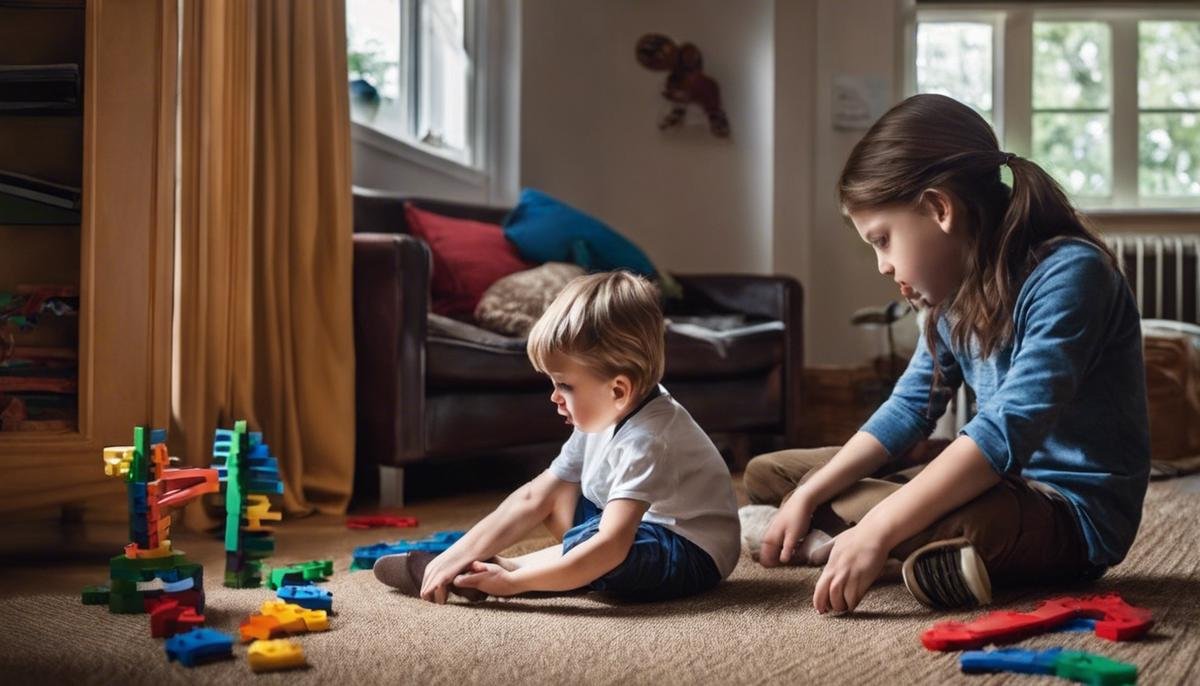
Aggressive behaviors such as biting and hitting are a struggle many parents of children with autism face. Autism refers to a wide range of conditions characterized by challenges with social skills, repetitive behaviors, speech, and nonverbal communication. Identified in one in 54 children in the United States, the aggressiveness associated with it, such as biting and hitting, are prevalent. This exploration delves into the complexities of these aggressive behaviors, their triggers, effects on family life, and management strategies. Through a profound understanding of these aspects, parents and caregivers can equip themselves better to address these behaviors effectively and create a harmonious home environment.
Autism and Aggression: An Overview
Understanding the Link Between Autism and Aggressive Behaviors
It’s a bright morning, the aroma of the freshly brewed cup of coffee hugs the air, and there at the corner of the living room, our darling child finds their world to be somewhat challenging to understand. Autism: it’s not just a word or a medical diagnosis, it’s a whole unique experience that our wonderful child lives day in and day out. As parents, we walk this path with them, diligently trying to navigate the twists and turns of their unique behavioral patterns. Among these behaviors, aggression, including biting and hitting, can often be a puzzling and concerning aspect for us.
Unraveling the Connection
So, what exactly is the connection between autism and aggressive behaviors such as biting and hitting? The main thing to remember is that these behaviors are often a means of communication. Our children with autism may lack the language skills necessary to express their needs, feelings, or frustrations. As a result, they may turn to physical forms of expression like biting or hitting.
What Triggers These Behaviors?
Aggressive behaviors in children with autism can often be linked to sensory overload. The hum of a fluorescent light or the feel of a new fabric can lead to frustration and anxiety, resulting in aggressive behaviors. Similarly, changes in routine or unfamiliar environments can become stressors, triggering coping behaviors which may be perceived as aggressive.
What Can We Do?
Understanding the root cause of these behaviors is the first step in addressing them. If we’re dealing with frustration-induced aggression, teaching alternative methods of communication, like using pictures or sign language, can be an incredibly useful tool. When sensory overload is a factor, creating a sensory-friendly environment or utilizing strategies like earplugs or weighted blankets can go a long way in reducing anxiety and frustration.
Professional help should never be underestimated. Therapists and medical professionals can provide a plethora of useful strategies and therapies, such as Applied Behavior Analysis, designed to reduce aggressive behavior in children with autism.
Closing Thoughts
As parents, it’s essential to remember, aggression isn’t a desired way of communicating for our children with autism. It’s simply sometimes the only way they know how to express their confusions, frustrations, and fears. And while it’s completely natural to feel overwhelmed at times, it’s equally important to understand that with patience, love, and the right tools, we can transform these moments into opportunities for growth and connection.
Indeed, this unique parenting journey might seem challenging at times, but it’s also filled with countless moments of joy, fulfillment, and profound love. Every day, our children teach us a little more about their world, helping us better bridge the gap between their experiences and ours.

Reasons Behind Biting and Hitting in Autistic Kids
The mysteries of the human mind continue to confound us, especially when exploring the nuances of autism. Unpredictable behaviors such as biting and hitting are cornerstones in this jigsaw puzzle and understanding their cause is critical. These behaviors can sometimes be seen in children who have autism and it’s crucial that we delve into the reasoning behind them, distinct from the traditional triggers and communication methods we addressed previously.
One of the primary reasons can be feelings of frustration. Just as typically-developing children go through periods of emotional volatility, children with autism also face such challenges. The difference, however, lies in their impaired expressive and receptive language skills. This often results in an inability to express these frustrations, leading to outbursts of physical aggression such as hitting and biting.
A struggle to comprehend social constructs and cues can also fuel these aggressive tendencies. The world of peer interaction, with its multitude of unwritten rules, can be overwhelming for children with autism. Misreading social cues, misunderstanding jokes, or not comprehending play can make them feel isolated, leading them to resort to hitting or biting as a way of managing these confusing interactions.
Another hidden factor is the need for self-stimulation or ‘stimming’. This is a self-soothing method that helps with managing the onslaught of sensory input, a constant in the lives of children with autism. This stimming can sometimes manifest itself as aggressive behaviors like biting or hitting when the standard methods of sensory input aren’t enough. While this might be alarming to some, it’s a way for the child to regain control over their sensory environment.
An overlooked aspect is the impersonal nature of biting and hitting. While these actions might seem aggressive, for a child with autism, they are a physical way to create space. Overwhelming situations or unwanted physical contact perturbs their carefully managed world. By resorting to such behaviors, they are merely creating a physical boundary, trying to cope with how they are processing a situation.
Addressing these behaviors requires an in-depth understanding of the child’s feelings, triggers, and ways of processing the surroundings. Developing alternate coping and communication mechanisms, consistency in routine, and sensory-friendly environments are a few examples of us stepping into their shoes and helping them navigate their world.
Remember, each child with autism is unique in their experiences, so there’s no ‘one-size-fits-all’ approach. Patience, understanding, and a little bit of creativity are key in aiding these children to thrive in their environments. While raising a child with autism can present unique challenges, the rewards are immeasurable. The journey may be filled with ups and downs, but it’s in those precious moments of triumph that you realize how truly resilient your child can be. With your unwavering support, there’s no limit to what they can accomplish in this extraordinary life.

Effects of Autism-related Biting and Hitting on Family Life
Effect on Family Lifestyle: The Reality of Aggressive Behavior in Autistic Children
Having an autistic child in the family inevitably affects the dynamics of the family’s lifestyle. Biting and hitting behaviors are common occurrences in autistic children and understandably can lead to tension within the family. This article discusses the impacts of such behaviors on family life and offers solution-oriented insights to address these concerns.
First and foremost, it’s essential to understand the profound impact that biting and hitting can have on both the child and family members. This can be emotionally taxing, often resulting in feelings of distress, anxiety and, sometimes, embarrassment. Simultaneously, the safety of family members, especially younger siblings, may be of concern.
Parents may find themselves arranging their entire schedule around minimizing triggers for their child, leading to reduced social activities. Friendships may struggle to withstand the strain, as arranging playdates or outings can become an ever-increasing challenge. As a result, families might experience feelings of isolation from their wider community which can lead to knock-on effects, such as low mood, feelings of isolation, and increased stress levels.
However, it’s important to remember that it’s not all gloom. With time, families can evolve and adapt to this new normal. Many find that facing these challenges together often strengthens family ties.
So, what can families do to manage these behaviors and maintain a harmonious household? Key among these is providing education for all family members. Understanding autism and its associated behaviors can enable families to be more empathetic and understanding, essentially fostering a more supportive environment for the child.
It can also be very beneficial to invest in family counseling. A professional counselor can provide strategies to cope, advice for managing stressful situations, and can help the family to work as a team, focusing on maintaining strong bonds during challenging times.
Another essential aspect is self-care for parents. Parenting a child on the autism spectrum can be overwhelming and it’s easy to neglect your own needs. It’s important to take time for yourself, keep connecting with friends, pursue passions, and indulge in activities that make you happy. In doing so, you are better able to provide the necessary care for your child.
Adapting the home environment can also assist in making behaviors such as biting and hitting less likely. Creating safe spaces for the child to retreat to when feeling overwhelmed, or sensory friendly environments that reduce the likelihood of sensory overload can significantly help to manage aggression.
Finally, parents must maintain open communication channels with educators and therapists. They play a vital role in helping your child develop the necessary skills to better communicate feelings and manage aggressive behaviors.
In conclusion, it’s crucial to understand that biting and hitting by autistic children is neither a reflection of your parenting nor the child’s inherent nature. It is a complex blend of frustration, communication barriers and sensory processing difficulties that are part and parcel of this neurodiverse condition. Adopting an empathetic, proactive and understanding approach can go a long way in managing these behaviors and fostering a happy, healthy family environment. Embrace the journey with all its rewards and challenges and remember, you’re doing your best, and that’s more than enough!

Behavioral Interventions and Strategies
While walking this journey of parenting a child with autism, it’s key for parents to also recognize the emotional impact of aggressive behavior on both the child and family members. It’s common for everyone in the family to feel the ripple effect of these behaviors, significantly altering family dynamics and social activities. There’s a palpable shift, not just in the rhythm of the household, but also in the emotional climate of the family unit. It’s important to approach these changes with understanding and acceptance.
Occasionally, the presence of aggressive behavior could lead to feelings of isolation and increased stress levels for families. As parents, it can sometimes feel like you are alone on this journey, which makes fostering an understanding community all the more critical. Don’t hesitate to reach out to other families going through similar experiences or connect with support groups. These networks can provide priceless tips and reassurances and remind parents they’re not alone.
In times of difficulty, remember that there is potential for your family ties to grow stronger in the face of adversity. Challenges together pave the way to resilience and unity within the family. It rests on the shoulders of each family member to learn and understand autism, its triggers, and combat factors. This collective understanding fosters an environment of patience and acceptance, enhancing the child’s progress while deepening family bonds.
Counseling could be another valuable asset for families. Family counseling sessions promote an understanding of individual experiences, and offer strategies for managing stress and enabling better communication. These sessions provide an avenue for expressing feelings and developing coping mechanisms tailored to each family member’s needs.
The mantra of, “You can’t pour from an empty cup,” rings especially true for parents dealing with aggressive behavior in children with autism. The necessity of self-care cannot be overstressed. Practicing mindfulness, maintaining a balanced diet, and regularly exercising can significantly reduce parents’ stress levels and increase their mental and emotional capacity to handle challenging situations.
Adapting the home to lessen the incidence of aggression is another effective intervention. The home should be made to cater to the child’s sensory needs, ensuring it’s a safe and hospitable environment. This includes consideration of color schemes, noise levels, and the organization of furniture and toys.
Maintaining open communication with your child’s educators and therapists is beneficial. Keep them informed about any changes or developments, so adjustments can be made according to the evolving needs of the child.
Remember, the aggressive behavior observed is not an implicit reflection of parenting skills or the child’s intrinsic nature. Aggressive behaviors, like biting and hitting, are forms of communication for the child, a way to convey their frustration or discomfort. It takes time, patience, and extensive intervention strategies for changes to take effect.
Finally, embracing the journey is a cornerstone of managing these behaviors. Each day brings with it novel challenges, but also new opportunities for learning and growth. Celebrate the small victories, and remember that every success, big or small, is a step towards progress. This journey is unique, as are the children living with autism. Their resilience and potential for accomplishment are testament to their innate strength. Let’s marvel at their journey and do our best to support them every step of the way.

Embracing Hope: Success stories and coping mechanisms
Now, after exploring all these pivotal points of understanding, addressing and managing the behavior of children with autism who tend to bite and hit, a burning question remains – are there success stories? Can families navigate this challenging path successfully and create a loving, nurturing environment for their autistic child?
Indeed, there are countless heartwarming tales of families who have stayed the course and witnessed dramatic transformations in their children’s behavior. It’s crucial to note that ‘success’ in this context does not mean an end to all biting and hitting; rather, it involves a significant reduction in these behaviors and much-enhanced communication and coping mechanisms.
One such inspiring story involves the Brown family. Their son, Jack, exhibited intense bouts of biting when he was overwhelmed. Through intensive work with ABA centers and incorporating sensory-friendly changes at home, they noticed a drastic decline in his aggressive behaviors. Today, Jack has mastered several rudimentary sign language signals, enabling him to express his needs without resorting to biting.
Similarly, the Thomas family was initially daunted by their daughter Mia’s hitting tendencies whenever her routine was disrupted. With continuous counseling, and the development of a consistent routine, Mia’s tantrums gradually lessened. By creating a pictorial routine chart, Mia learned to anticipate changes which drastically cut back on her hitting incidents. Mia now uses a handful of phrases to indicate her discomfort or ask for aid, marking a significant improvement in her ability to express herself.
The Green family’s journey with their son, Max, is another testament to the power of perseverance and understanding. Max’s stimming often involved hitting others. By incorporating sensory activities at home, such as a sensory box and swing, they offered him alternatives for self-stimulation. The results were heartening – Max has shifted to less harmful forms of stimming and, in turn, brought about a calmer, happier home environment.
These families’ experiences embolden others in their parenting journeys. These triumphs underscore the power of support, understanding, consistency, and the use of alternative communication strategies. Each success story emphasizes the importance of maintaining an open dialogue with educators, therapists, and the larger community, reminding everyone involved that they are not alone on this journey.
These stories also reaffirm the truth that progress can be achieved, even under challenging circumstances. They remind us that every effort towards achieving every small victory should be celebrated. Every step forward is a testament to the strength and resilience of these children and their families. These multitudes of stories serve as beacons of hope for many families learning to navigate life with autism. They demonstrate that while biting and hitting may be a part of the autism journey, they don’t define it. These vibrant stories of success teach us that love, patience, understanding, and consistent effort can indeed pave the way for profound progress.

Given the right tools and guidance, families can successfully navigate the challenges of autism-related aggression. Behavioral interventions and purposeful strategies are instrumental in reducing instances of biting and hitting. Undoubtedly, managing these behaviors demands considerable effort and patience from families, but the transformation can bring about positive changes in family dynamics. The journey may be arduous, but there is hope and potential for peaceful co-existence. A bond forged in adversity is stronger, and the success stories featured herein are a testament to that strength. Stay informed, be patient, keep loving, and remember that this journey can lead to personal growth for all involved.





